BigCommerce stands out as a highly recommended eCommerce platform, equipped with an extensive array of built-in tools that surpass its competitors. However, to make the best use of this solution, it is important for owners to learn everything about BigCommerce API.
LitExtension – #1 eCommerce Migration Service can not let you be left behind without knowing how. In today’s guide, we will answer the following questions:
- Definition, types, and functionalities of BigCommerce API;
- The guide to getting the API credentials on BigCommerce;
- Some related tasks to these BigCommerce APIs.
Wait no more; let’s dive in!
Power Your Vision on BigCommerce with LitExtension
Our team of experts can safely transfer your business data, products, customers, and orders to unlock more growth in this promising eCommerce platform. Let us provide a customized migration for you!
What is BigCommerce API?
An API, or Application Programming Interface, acts like a digital messenger between different software applications. In other words, APIs allow different software systems to talk to each other, exchange information, and work together seamlessly.
The BigCommerce API is a specific type of API that enables businesses to automate tasks and build custom integrations on the BigCommerce platform. In particular, such APIs provide access to a wide range of store management and customer-facing features, including managing products, orders, customers, carts, checkouts, and more. This allows for powerful customization, ultimately leading to greater efficiency and flexibility in managing your online business.

In addition, BigCommerce APIs also facilitate the management of store data, customer authentication, and client-side queries for product details, among other functions. They provide a wide range of endpoints, webhooks, and essential solutions designed to support the growth of merchant businesses.
Types of BigCommerce API Calls
BigCommerce offers various store APIs designed for tasks such as handling store data, authenticating customers, making client-side queries for product information, and more. For store owners, understanding these API types is essential, whether you're planning to develop solutions yourself or hire a developer.
In the following BigCommerce API reference, we have outlined some essential types you might need to differentiate when being a store owner.
REST Store Management APIs
The REST Store Management APIs allow you to automate transactions and make changes to your store's data programmatically. These APIs have various use cases, including adding and updating products in the store, updating inventory levels, creating coupons, and managing a customer’s account details. They serve as tools to help you operate your online store efficiently.
GraphQL Storefront API
If BigCommerce REST Store Management APIs are for managing the backend of your store (like products, orders, etc.), the GraphQL Storefront API is all about creating a dynamic and engaging front-end experience for your shoppers. It is a versatile interface for accessing and configuring storefront data, enabling developers to build headless storefronts and enhanced Stencil themes.
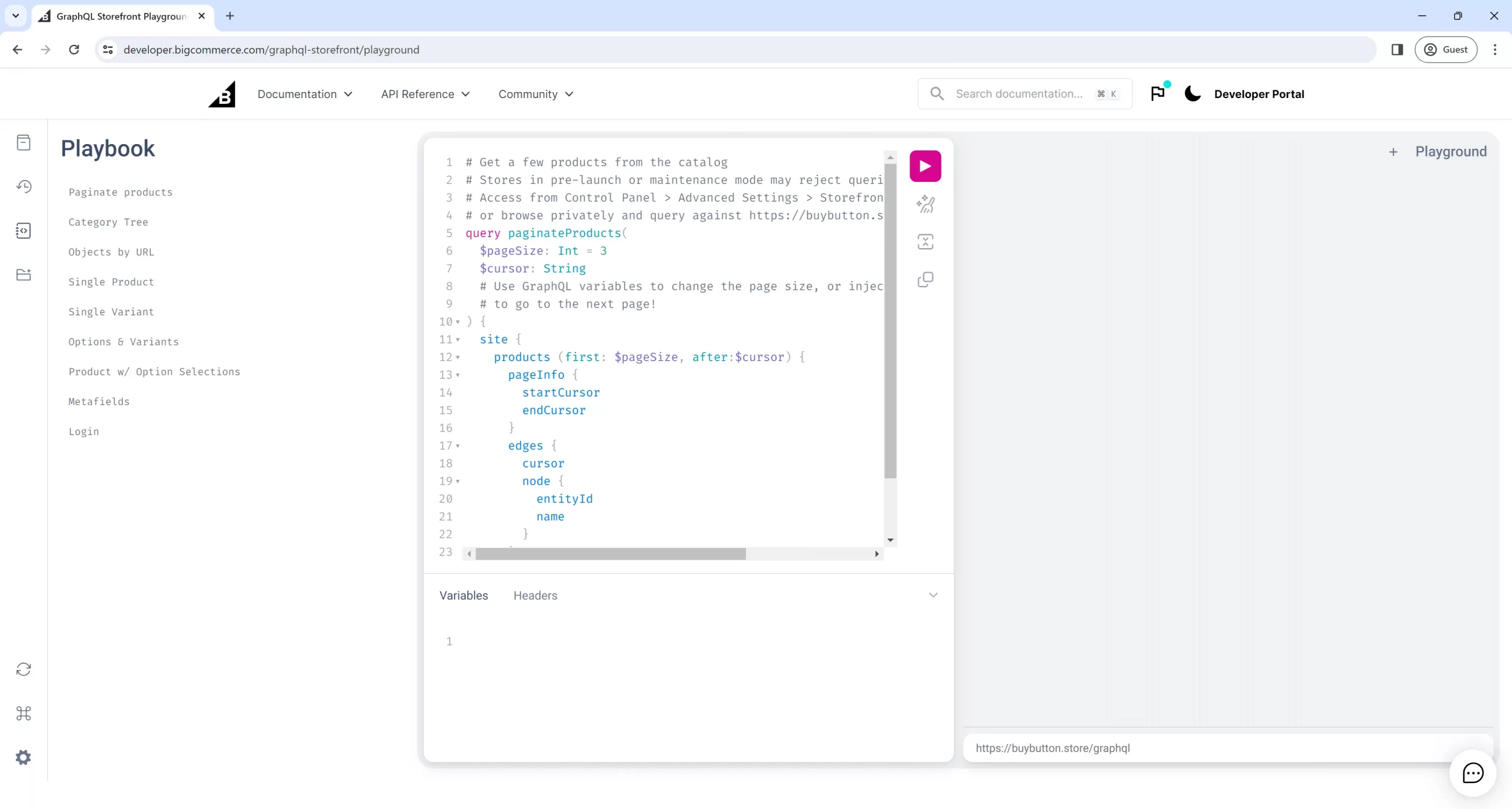
The GraphQL Storefront API enables the retrieval of precise product catalog data, facilitating advanced searching, filtering, and sorting functionalities. Developers can request product images at any resolution and access customer details, such as names, email addresses, and attributes. Most importantly, the API leverages the efficiency of GraphQL, allowing developers to retrieve data for multiple resources with a single request.
Checkout API
The BigCommerce API for checkout allows developers to customize and extend the functionality of the BigCommerce checkout process. While the standard BigCommerce checkout is already quite robust, this API gives you the freedom to tailor it precisely to your needs or integrate it into a completely custom storefront.
It supports building custom checkout experiences, including customer login, shipping quotes, and payment processing. These tools enable developers to create tailored checkout solutions for various use cases, from headless commerce to mobile applications.
Customer Login API
If you want to integrate secure and single sign-on (SSO) experiences for your customers, you might want to leverage Customer Login API. This enables your customers to access their store accounts using credentials from established identity providers or even their own existing login systems.
Beyond SSO, this API type also unlocks a world of possibilities for customizing the authentication flow. You can leverage this API to enable alternative login methods like phone number verification, providing a smoother experience for users who prefer not to juggle multiple passwords.
Current Customer API
With the Current Customer API, you can differentiate signed-in customers from guest users. It helps you identify which customer is logged in to a storefront during a session. You can confirm a customer’s identity in the browser and validate it to display specific information to them from an external app.
Payments API
BigCommerce has a Payment API that helps you handle payments through the store’s payment gateways. Shoppers pick their preferred payment method and complete their purchase. Once the payment goes through, the order is created using the Order API or Store Management Checkouts API. After that, you can receive the payment in your connected account, often PayPal.
Catalog API
The Catalog API lets you manage your store's products, brands, bulk pricing rules, and categories. It supports CRUD operations (Create, Read, Update, Delete) on all catalog-related entities, making product management easier. With this API, you can update products, add new variants when you launch or upgrade items, and enhance their display on your storefront.
Shipping API
With the Shipping API, you can create shipments from orders and even make multiple shipments from one order. BigCommerce’s V2 Shipping API lets you manage shipping zones, methods, and carrier connections. After creating a shipment, you can set the shipping provider, tracking number, and shipping address ID and keep the customer updated for order transparency.
Core BigCommerce API Functionalities
Now that we've explored the different categories of API calls BigCommerce offers, let's go through the heart of its capabilities. The core functionalities of the BigCommerce API provide the building blocks for crafting rich, customized eCommerce experiences.
Manage carts, checkouts, and orders
BigCommerce understands that a smooth and efficient checkout process is crucial for any online business. Their APIs give you comprehensive control over managing carts, checkouts, and orders.
More specifically, its REST Management API and REST Storefront API let you manage and handle carts and checkouts, while the GraphQL Storefront API helps with mutations. These functionalities help you ensure a seamless shopping experience, from cart creation to order fulfillment.
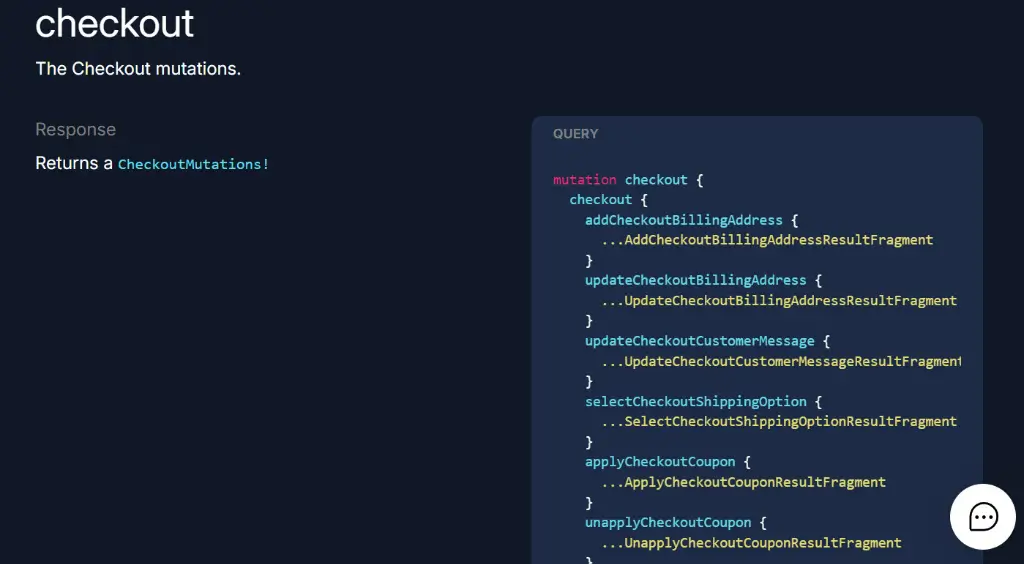
Build catalog
The Catalog API allows you to create and manage your store’s products, categories, brands, and bulk pricing rules. This includes performing CRUD (Create, Read, Update, Delete) operations on catalog entities, allowing for easy updates and management of product listings, variations, and pricing.
GraphQL Storefront API and REST Management API will help you do that. You can check BigCommerce API documentation for Catalog, including products, categories, and brands to see the details.
Manage customers
Another functionality of the APIs is helping you manage customer data. It includes creating and updating customer profiles, managing customer groups, and accessing customer login information. This functionality is essential for personalized marketing and customer relationship management.
Design themes
Beyond back-end efficiency, BigCommerce APIs also give you the creative freedom to craft unique and engaging storefront designs. Comprehensive access to theme files and template customization ensures that all visual elements, including typography, color palettes, and layout structures, follow a consistent design language.
Besides that, you can also extend storefront functionality by inserting custom scripts. From embedding robust analytics dashboards for data-driven decision-making to incorporating real-time customer support tools like live chat plugins, these features ensure a highly customized shopping experience.

Register Webhooks
This functionality lets you register and manage webhooks to receive notifications about store events. This includes order creation, product updates, and customer actions. It’s a necessity to automate workflows and integrate them with third-party services.
How to Get Your BigCommerce API Credentials?
As we have stated previously, obtaining BigCommerce API credentials is essential when you want to migrate from or to this robust platform. However, before that, you must create an API account according to your business model.
From the control panel, you can create two distinct types of BigCommerce API accounts:
- Store-level API accounts: Specific to a particular store.
- Account-level API accounts: Operational across all stores within your BigCommerce account.
For each type, the steps to get your BigCommerce API credentials differ. Thus, we have included detailed tutorials for both. Carefully read the API description to see which type suits you, and follow the instructions.
✅ There are a few prerequisites you need to fulfill to be eligible for creating BigCommerce API accounts:
- Account-level accounts are only available for store owners.
- Only accounts with high-risk user permissions can access, generate, and manage store-level API accounts.
- If you want to view webhooks, the store owner must grant permission to read webhooks to your account.
1. For store-level accounts
Store-level API accounts are equipped with a fixed access token that remains constant. Typically, the BigCommerce APIs for store-level accounts consist of the following:
client_id: Recognizes the application, user, or client initiating a request.client_secret: Acts as a securely encrypted value that is exclusive to only you and BigCommerce.access_token: Accompanies with the majority of REST API requests.- Client name: Adds a label for your convenience and doesn’t relate to the API requests.
- API path: Represents the URL to which you are directing requests to. Although the API path experiences no changes, it may have either /v3/ or /v2/ added to it, depending on the version of the endpoint you are querying.
Important note: Avoid transmitting your client_secret or access_token as plain text or in an unencrypted payload. Be cautious, especially with the client_secret, as an attacker could utilize the shop API to steal your private data.
Now that we have grasped what store-level accounts include and how they work, it’s time to create one for your store.
Step 1. Open the Store-level API accounts menu
Firstly, navigate to the Settings > Store-level API accounts menu from your BigCommerce admin panel. This is where you will notice the “+ Create API Account” button; click on it for the next step.
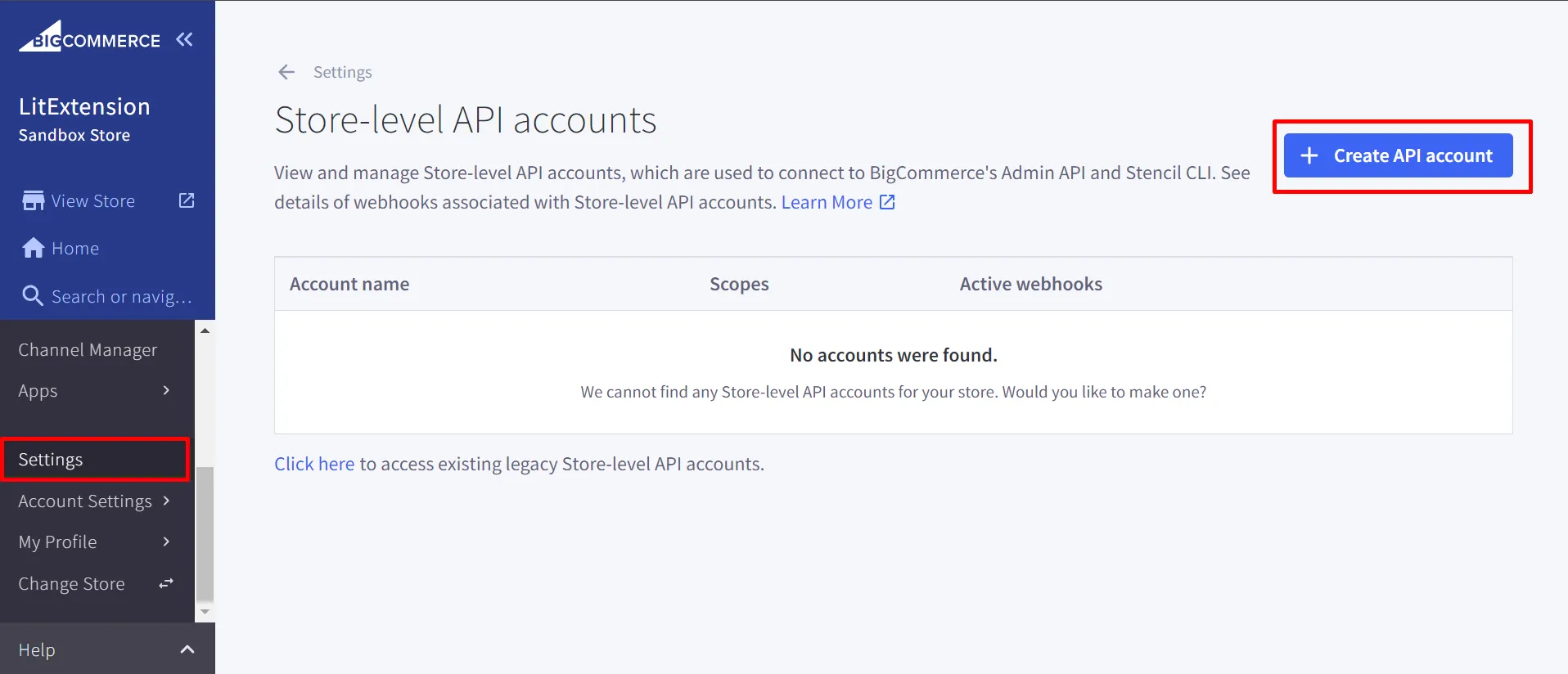
Step 2. Choose a Token Type
Then, you will have to select between two token types from the drop-down, with the latter being utilized in BigCommerce theme customization tools:
- V2/V3 API token.
- Stencil-CLI token.
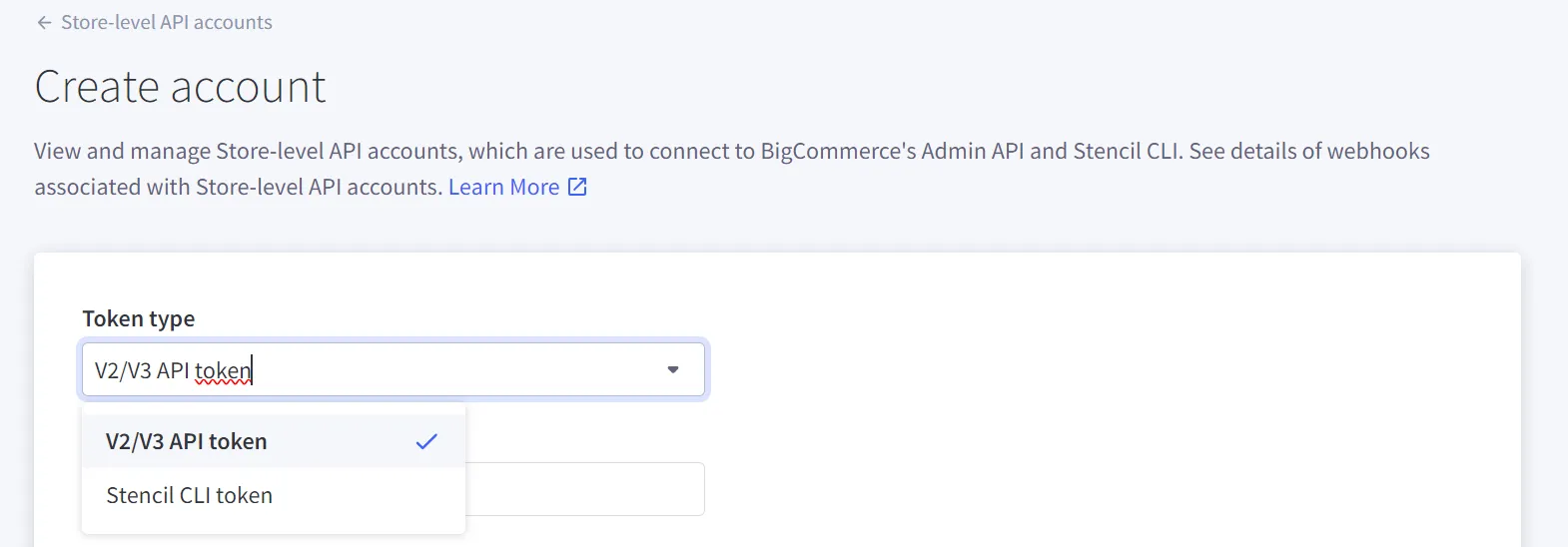
Step 3. Come up with an account name
Next, fill in the account name in the input field. Please make sure that the name must be at least 4 characters in length.

Step 4. Decide the access level
This applies to those of you who have chosen the Stencil-CLI token type from the second step. You may refer to Live Previewing a Theme in the Dev Center for more information on Stencil-CLI tokens.

Step 5. Determine the API resources
For V2/V3 API tokens, take note of the API path, as it is essential for utilizing the API account. To continue, in the OAuth Scopes section, outline the API resources and permissions necessary for your application or integration to access.
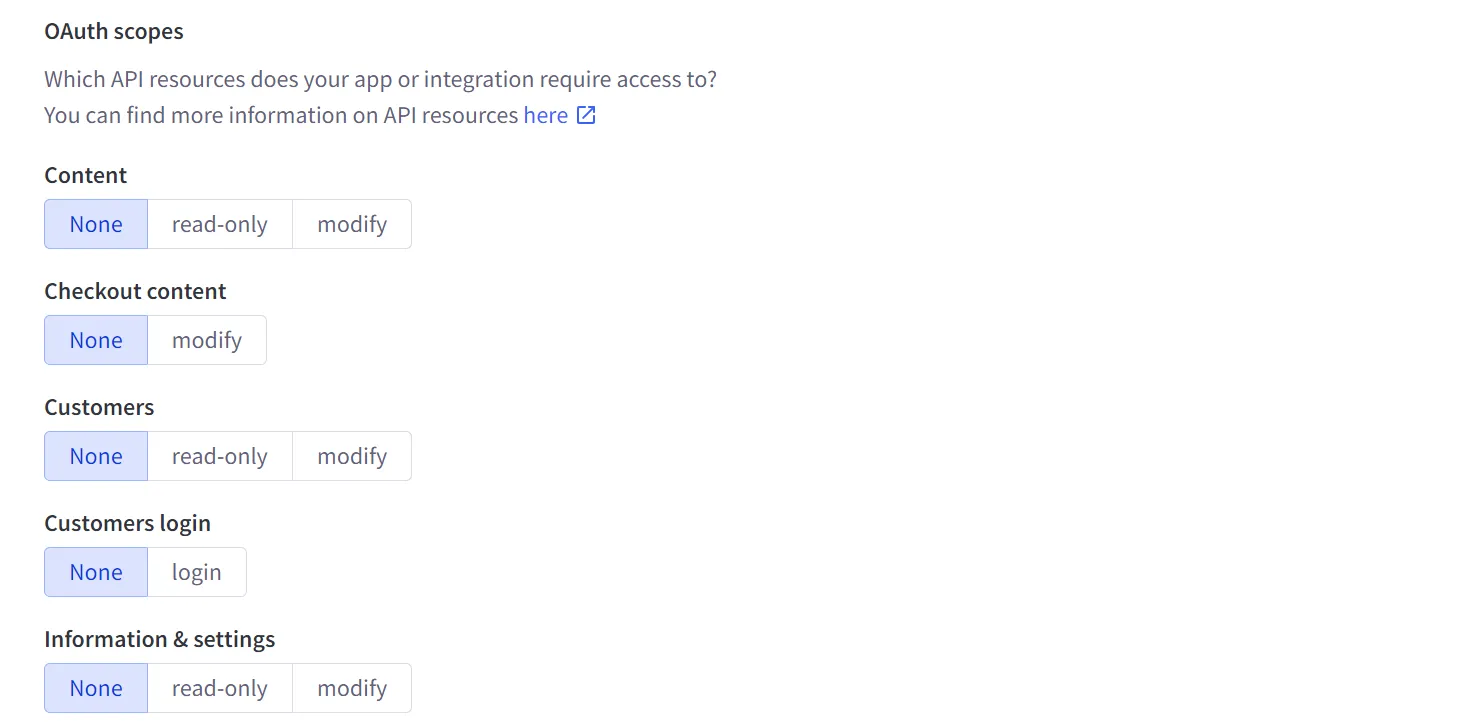
BigCommerce provides a range of OAuth Scopes to tailor and manage access to your store's data. For additional details, refer to the BigCommerce API Documentation in the Dev Center.
Step 6. Click Save
Finally, hit “Save” when you’re done with all the BigCommerce API settings. A successful save will trigger a pop-up window revealing the API credentials, and your browser will prompt you to download a .txt file containing the same credentials for secure storage on your computer.
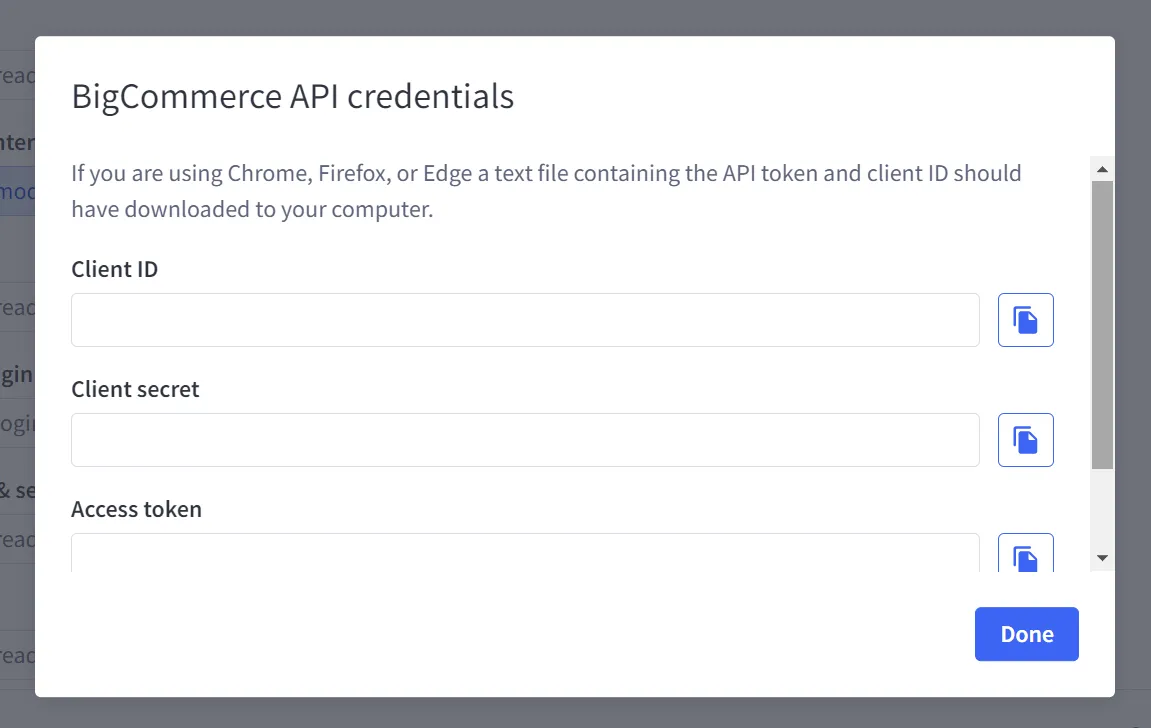
Make sure that you store your credentials carefully, as you can’t return to this pop-up after dismissing. For V2/V3 API tokens, you should add the API Path value from Step 5 to these credentials, because it is used with the token for all API calls.
2. For account-level accounts
If you are managing multiple stores at once, create an account-level account instead of the store-level one. The steps are quite simple, too.
Step 1. Navigate to the Account-level API Tokens page
Also, from your “Settings” menu, go to the “Account-level API Tokens”. Once there, select the option “+ Create Account-level API account”.

Step 2. Fill in the Token Name
Moving on, provide a name for the app or integration associated with the API token. Then, either copy or take note of the API path, since it will be necessary for utilizing the API account.
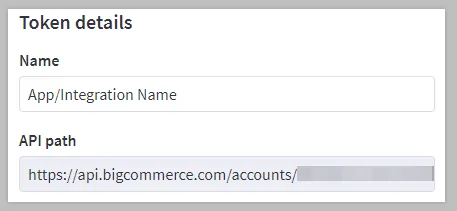
Step 3. Specify the API resources
In the OAuth Scopes section, outline the API resources and permissions essential for your app or integration to access. Keep in mind that you have the option to choose more than one option per resource.
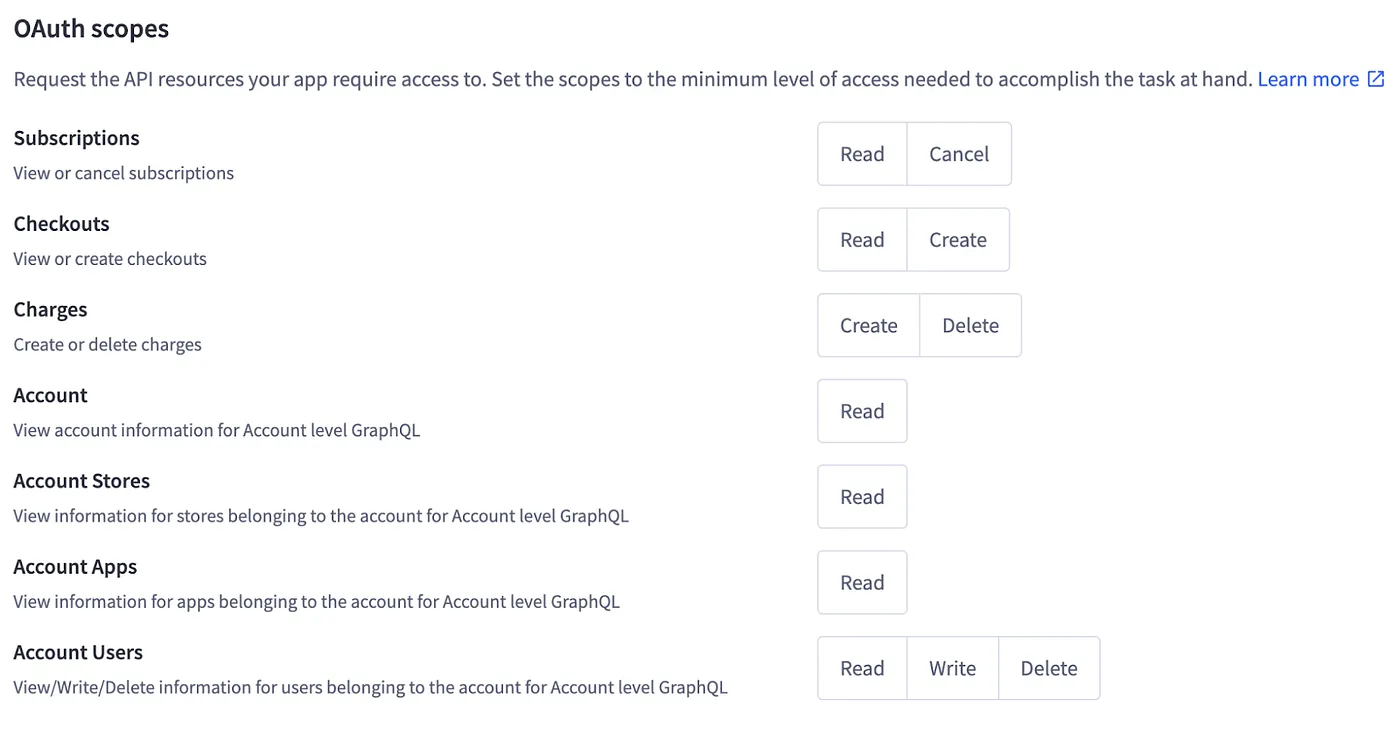
Step 4. Save your API credentials
After completing your modifications, it’s time to “Save” your settings. A successful save will present a pop-up window featuring the API credentials. Additionally, your browser will prompt you to download a .txt file containing identical credentials for secure storage on your computer.
Save Time Import Store Data to BigCommerce
Trusted specialists streamline migrations that actualize ambitions.
- Personal Assistant
- Unlimited free demo
- Personalized migration
- Free additional options
How to Perform Tasks Related to Your BigCommerce API?
Besides the creation of BigCommerce API accounts, you will also have the opportunity to perform other related tasks, such as:
Keep reading to find out how for each task!
1. Delete the account
To remove a Store API account, choose the “Delete” option from the “Action” menu.

A confirmation pop-up window will appear before the account deletion can proceed. If there is an associated webhook with the account, you must enter the API account name into a field. Once acknowledged and the button is enabled, proceed to click “Delete”.
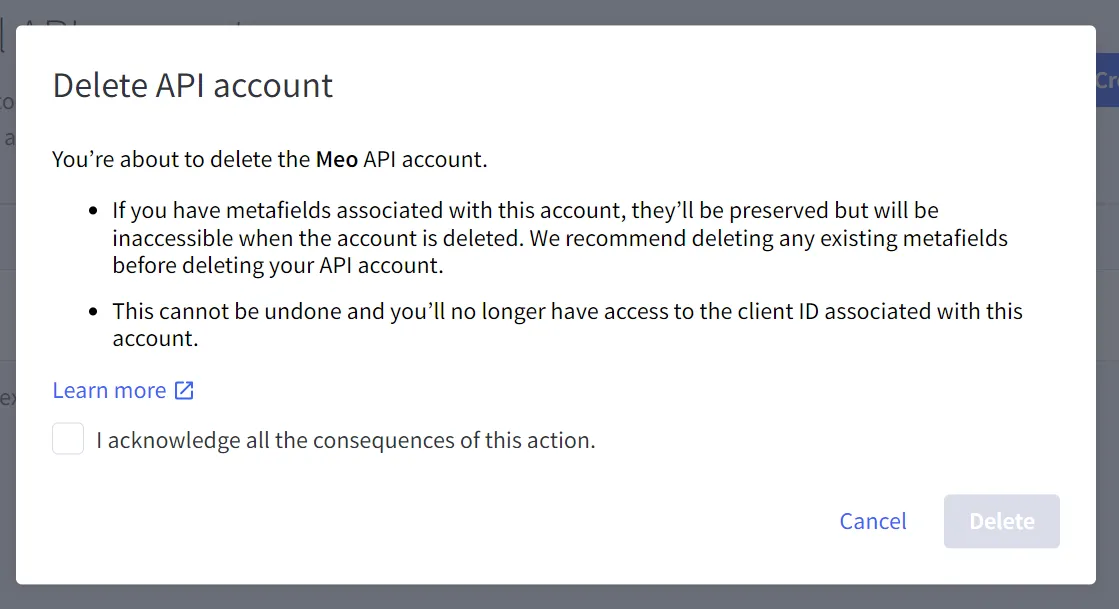
Nevertheless, be aware of the following points when deleting your API account:
- Webhooks linked to the account will also be erased.
- If there are metafields linked to this account, they will be retained but inaccessible once the account is deleted. It is advisable to delete any existing metafields before removing your API account.
- This action is irreversible, and you will lose access to the client ID associated with this account.
2. Keep track of webhooks
Webhooks inform applications about specific events happening on a BigCommerce store. After establishing a store-level API account, you can check the status of active or inactive webhooks. Then, identify any currently blocklisted webhooks, and ascertain the domains linked to a store.
To inspect the webhooks linked to a BigCommerce API account, opt for the Edit option from the Action menu. At this point, a list of webhook events, accompanied by the Destination URL, Created date, and Status for each event, will be displayed.

3. Activate email notifications
For effective management of webhook events, you can turn on email notifications for real-time notice. This enables you to receive alerts when a webhook is deactivated or when a domain is blocklisted, facilitating prompt response to any arising issues.
Navigate to the Notification email tab and input your email address.
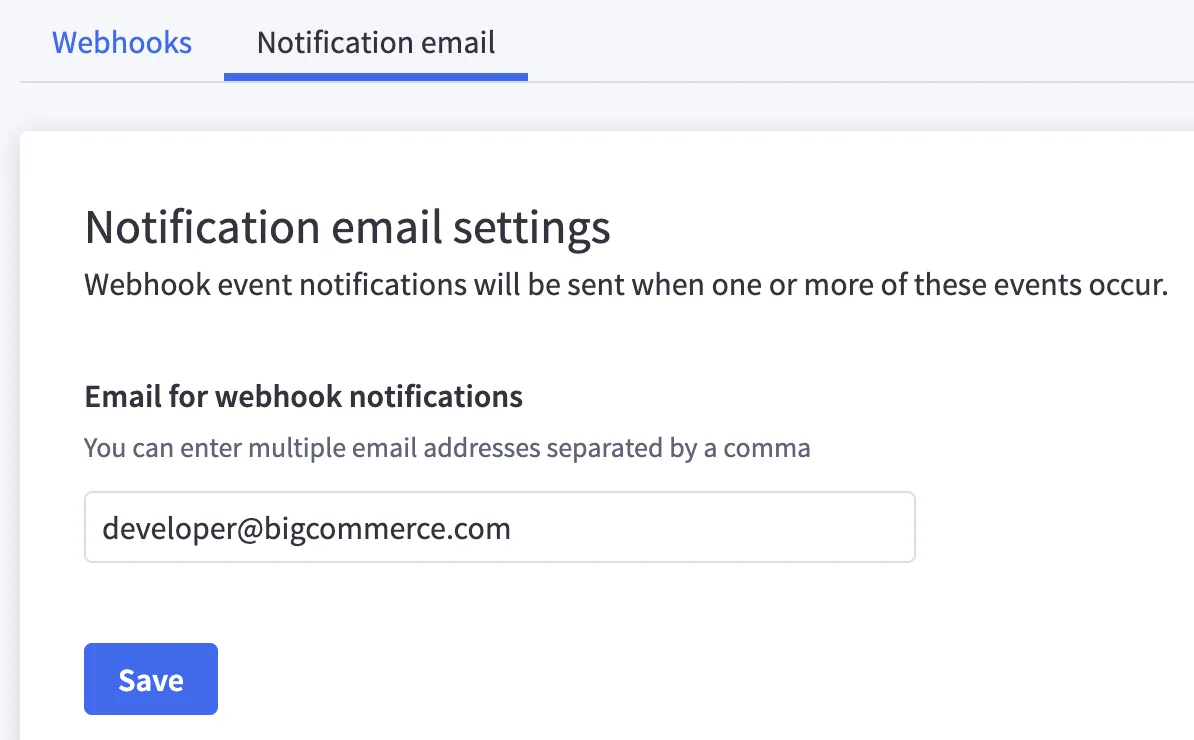
Feel free to add as many email addresses as you want, separated by commas. When everything has fallen into place, click on “Save”, and you are good to go.
BigCommerce API Documentation: FAQs
Does BigCommerce have an API?
Yes! In BigCommerce, API (Application Programming Interface) refers to a set of tools and protocols allowing developers to interact with and access the features of the BigCommerce platform programmatically. The BigCommerce API enables the manipulation of store data, facilitates the creation of custom integrations, and supports various functionalities within the eCommerce store.
What is storefront API in BigCommerce?
The BigCommerce Storefront API is a specific API that primarily focuses on providing programmatic access to the storefront-related features of an online store. It allows developers to retrieve product information, manage customer data, and interact with the storefront dynamically.
Does BigCommerce have Webhooks?
Yes, BigCommerce offers a robust webhook system. Webhooks allow you to receive real-time notifications on events within your BigCommerce store, such as orders, product updates, or customer changes, sending data to your specified URLs.
What programming language is BigCommerce?
BigCommerce isn't built on a single programming language. It uses a combination of languages for its front-end (like Javascript and Stencil, their templating language) and back-end infrastructure. That said, developers use languages like Ruby, PHP, Java, and Python to build custom functionalities and integrations on the BigCommerce store.
How to get BigCommerce API credentials?
To get your BigCommerce V2/V3 API access token, follow the below steps:
- First, log in to your BigCommerce control panel.
- Once you’re in, look over to the left-hand menu, click on ‘Settings,’ then scroll down until you see ‘API.’ Under that, click on the ‘Store-level API accounts' button.
- Then click on ‘Create API Account'.
- For the Token type, select ‘V2/V3 API token'.
- For the Account name, enter something memorable since this will make it easier to identify later if you need to manage your API accounts.
- Under ‘OAuth Scopes,’ select the maximum scopes for all fields, including Content, Customers, Orders, and more.
- Click Save and you will now receive your Client ID, Client Secret, and Access Token. Remember, you won’t be able to view the Access Token again, so make sure to save it securely for future use.
Key Takeaways
BigCommerce APIs are powerful resources that enable seamless integration and customization of your eCommerce store. With its support, you can efficiently manage carts, checkouts, orders, products, customers, and more. Whether you are a developer, store owner, or entrepreneur, utilizing these APIs will enhance your store’s capabilities and improve your customers’ experience.
If you plan to perform a BigCommerce migration, LitExtension is here to help! All you have to do is provide us with the store information and its API key. Then, leave the rest to us.
For further blogs like this, you can browse through our LitExtension blog on BigCommerce or join the Facebook community group!


